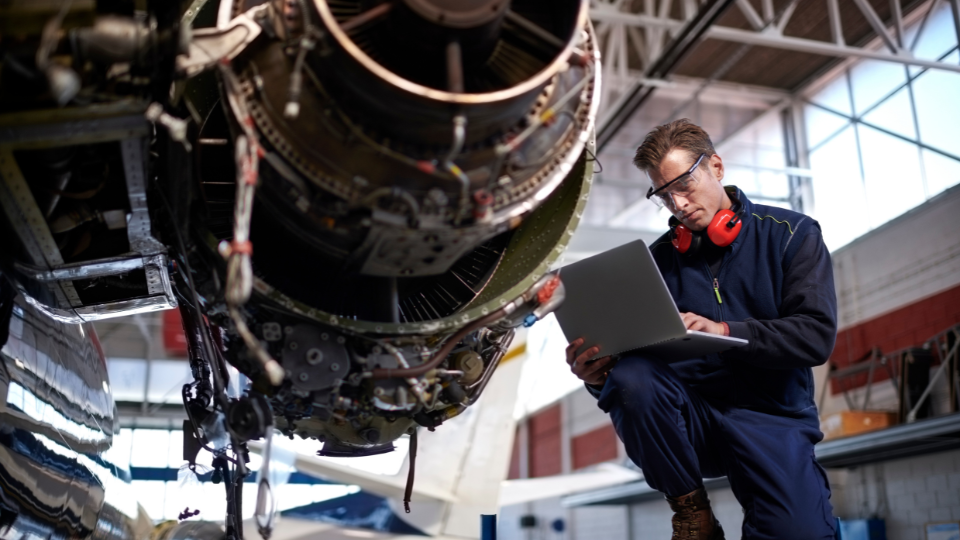
When an aircraft misses a maintenance deadline, the entire operation can come to a standstill. If you're responsible for keeping planes ready and safe, you know how quickly a small planning error can turn into a big problem.
Aircraft maintenance planning isn't just about following a schedule; it's about staying ahead of issues, protecting your fleet, and avoiding costly surprises. With the right approach, you can keep your aircraft flying and your operation running smoothly.

Aircraft maintenance planning is the strategic process of organizing, scheduling, and managing all maintenance activities required to keep aircraft safe, reliable, and compliant with regulations. You use this process to forecast upcoming maintenance needs, allocate resources efficiently, and ensure parts availability before work begins.
The global aircraft maintenance market was valued at USD 87.67 billion in 2024 and is projected to reach nearly USD 145 billion by 2034, highlighting just how essential effective planning is for cost control, compliance, and operational reliability at scale.
Effective aviation maintenance planning transforms reactive, emergency-based maintenance into a proactive, controlled process. This shift helps you maximize aircraft availability while minimizing unexpected downtime and operational disruptions.
Did You Know: Unscheduled maintenance is among the top reasons for flight delays and accounts for 88% of an airline's Direct Maintenance Cost (DMC).
Aircraft maintenance management begins with understanding these essential planning components:
Your maintenance planning system should integrate these components into a unified process. This integration helps you maintain visibility across all maintenance activities and avoid the pitfalls of disconnected planning.
Effective maintenance planning isn't a solo effort—it's a coordinated process that brings together multiple roles, each responsible for a key piece of the puzzle. Clear ownership across these roles helps ensure that no task slips through the cracks and that compliance, safety, and readiness are always in sync.
Together, these roles form the backbone of a reliable maintenance operation. When well-aligned, they enable proactive planning, smooth coordination, and responsive execution, keeping your fleet compliant, efficient, and ready to fly.
Before building an effective maintenance plan, you need a solid understanding of the regulatory framework that governs your operation. Authorities like the FAA and EASA mandate specific procedures, intervals, and documentation standards that must be factored into your planning process from the beginning, not as an afterthought.
Every inspection, part replacement, and recurring task must align with approved maintenance programs. Your planning system should help you track deadlines, stay current with service bulletins, and document all completed work in an audit-ready format.
Key planning documents include:
Whether you manage maintenance internally or coordinate with a CAMO, your documentation and scheduling must meet regulatory expectations. Modern planning systems like SOMA Software offer directive tracking, task verification, and audit trails to ensure ongoing compliance without disrupting daily operations.
Case Study: How ATSA Optimized Aircraft Maintenance with SOMA Software
Discover how ATSA streamlined its maintenance operations, improved regulatory compliance, and reduced downtime using SOMA Software. This real-world example shows how modern planning tools make a measurable impact. Read the Case Study
Maintenance strategies generally fall into two categories: short-term and long-term planning. Each plays a vital role in balancing the needs of daily operations with broader maintenance and compliance goals.
Table: Tactical vs. Strategic Maintenance Planning

Effective maintenance planning helps streamline many processes and ensures a seamless process. Benefits include:
A well-structured maintenance plan keeps more aircraft in service by reducing unscheduled downtime. When you anticipate maintenance needs, you can schedule work during non-peak hours and maintain higher fleet availability.
Proper planning allows you to identify and address potential safety issues before they lead to incidents. Regular inspections and timely component replacements contribute to safer operations and regulatory compliance.
Your maintenance planning directly impacts safety outcomes by ensuring critical tasks are never missed or delayed. This proactive approach creates multiple layers of protection against mechanical failures.
Effective planning reduces costs by preventing emergency repairs, minimizing overtime labor, and avoiding rush shipping for parts. By managing resources efficiently, you keep maintenance expenses predictable and controlled.
The financial benefits extend beyond direct maintenance costs. Better planning reduces schedule disruptions that lead to passenger compensation, hotel accommodations, and other operational recovery expenses.
Clear plans enable seamless coordination between maintenance, inventory, and flight operations teams. Your technicians spend less time waiting for instructions or searching for parts when maintenance activities are properly planned.
This improved workflow allows your team to complete more tasks in less time. It also reduces the stress and burnout that often result from constantly reacting to unplanned maintenance events.

Even well-designed planning systems face practical challenges in implementation. Common obstacles include:
Successful planning requires ongoing coordination across departments and the flexibility to adapt when circumstances change. Your planning process should include regular review meetings to address emerging challenges.
Explore Proactive Maintenance Planning Solutions
SOMA's Aircraft Maintenance Management solution helps you overcome the common challenges of fragmented workflows, parts shortages, and reactive planning.
Learn More About the Platform

If you're new to maintenance planning or looking to build a better process from the ground up, these practical steps can help you simplify operations, reduce errors, and increase fleet readiness:
Start by documenting your current planning process from end to end. Identify each step involved, from scheduling tasks to assigning personnel and tracking completions. Pay close attention to handoffs between departments, communication breakdowns, and recurring delays.
This audit helps you visualize where inefficiencies exist and sets a baseline for improvement. Even if your system is informal, writing it down gives you clarity and creates a reference point for implementing better workflows going forward.
Select a scheduling approach that matches your operational needs and fleet complexity. Small operators may benefit from task-by-task scheduling, while larger fleets often use block maintenance to group tasks efficiently.
Your scheduling strategy should balance maintenance requirements with operational demands. Consider how your aircraft utilization patterns affect maintenance opportunities and constraints.
Fragmented tools lead to missed tasks, duplicated work, and poor communication. Replace scattered spreadsheets, paper logs, and siloed systems with a centralized platform that consolidates planning, inventory, and compliance in one place. This allows your team to access real-time information and coordinate more effectively across departments.
Even simple digital solutions improve consistency and audit readiness. If you use maintenance software like SOMA, you can streamline operations while minimizing risk and administrative overhead.
Build flexibility into your schedule by allowing buffer time between major tasks. Track components with higher failure rates so you can anticipate potential disruptions.
Your plan should include contingency resources for unexpected findings during inspections. This preparation helps you respond quickly when unscheduled repairs arise without derailing your entire maintenance schedule.
Forecast maintenance hours needed each week or month, and match these requirements to technician availability. Use planning tools to prevent resource overloads and reduce costly overtime.
Your labor planning should account for technician specializations and certification requirements. Ensure you have the right mix of skills available for scheduled tasks, especially for specialized systems or components.
Larger inspections, overhauls, or calendar-driven tasks often require weeks of preparation. Set automated reminders for these long-lead activities to give your team time to order parts, schedule labor, and prepare tools. Even simple calendar notifications or software-based alerts can prevent last-minute scrambles.
Ideally, reminders should escalate over time, starting at 60 days out and increasing in urgency. This approach keeps you ahead of compliance deadlines and allows your team to plan with confidence.
Start every job with a clear understanding of which parts are required and whether they're on hand. Confirm inventory availability during the planning phase, not after a technician opens a panel. For critical components, check lead times and order well in advance. AOG delays are often caused by preventable part shortages.
By aligning inventory checks with your maintenance calendar, you can minimize delays, reduce emergency shipping costs, and ensure that work proceeds on schedule.
Shared responsibility can quickly lead to confusion and dropped tasks. Assign ownership for key parts of the planning process, such as scheduling, parts coordination, task tracking, and sign-offs. When roles are clearly defined, accountability improves, and tasks are less likely to fall through the cracks.
In small teams, one person may wear multiple hats, but responsibilities should still be documented. This structure helps teams work more efficiently and improves communication during busy or high-pressure periods.
Tracking the right KPIs helps you monitor the impact of your planning process and identify areas for continuous improvement. Here are five metrics that matter:
Review these KPIs monthly or quarterly to spot trends, identify areas for improvement, and evaluate changes in planning effectiveness over time. SOMA Software provides easy access to real-time metrics through integrated reporting.
Effective aircraft maintenance planning forms the foundation of reliable, cost-effective, and compliant fleet operations. By implementing structured planning processes and leveraging integrated tools, you can maximize aircraft availability while minimizing costs.
SOMA Software provides aviation operators with a comprehensive platform to centralize maintenance management, automate compliance tracking, and improve team coordination.
See how SOMA keeps your fleet in the air and get a quote today.
The Aircraft Maintenance Manual (AMM) provides detailed procedures for performing specific maintenance tasks, while the Maintenance Planning Document (MPD) outlines when and how often these tasks should be performed based on manufacturer recommendations and regulatory requirements.
Aviation maintenance planning involves stricter regulatory oversight, more complex documentation requirements, and greater emphasis on safety-critical systems than general industrial maintenance planning, with specialized tracking of flight hours, cycles, and calendar-based maintenance intervals.
Modern aircraft maintenance planning relies on specialized software systems that integrate task scheduling, resource management, inventory control, and compliance tracking, replacing the spreadsheets and paper-based systems that were once industry standard.